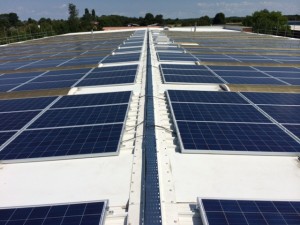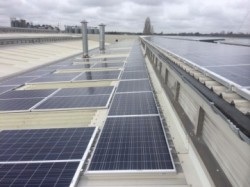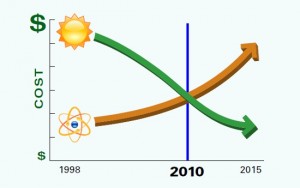What is EMR?
EMR stands for Energy Market Reform. It is a policy created by the government to incentivise investment in low carbon technologies such as renewable energy.
It is a levy applied to consumers which has been designed to encourage users to reduce their consumption or make a contribution to meet future demands.
EMR will be implemented by way of additional charges onto your electricity bills to meet the £100BN of capital investment the UK require to meet future projected energy demand.
Albeit a gradual ascent, the next year or two is expected to see this ‘tax on consumption’ rise sharply. The more you consume, the more you will be charged.
Consumers could see as much as a 42% increase in energy costs as a result of EMR and other related charges.
Provide or Reduce?
The thinking behind this reform is to charge electricity customers to either:
- PROVIDE funds to the 100BN investment pot needed to meet the infrastructure demands
- Encourage them to REDUCE their carbon consumption and use secure future-proof technologies
As consumers, we have two options –
Provide: In addition to our energy costs, pay a consumption based levy to fill the coffers pot.
Reduce: Make changes to our consumption. Install technologies to future-proof our businesses and homes. Renewable energy solutions to meet our requirements will help us to avoid high EMR charges, reduce our energy bills and grid consumption.
What’s in it for me?
By installing a renewable technology to generate your own electricity you will become a ‘Generator’ and you may also be able to obtain CfD (Contract for Development) payment alongside a reduced ERM contribution.
CfDs are payments made to the Generator by a Low Carbon Contracts Company (LCCC) for renewable electricity sent back to the network for use at times of peak demand or shortage.
The cost of the CfD payments to generators will incidentally be met through the EMR related charges on consumer’s bills.
If you remain dependent on the grid, and as a result of EMR you will effectively be funding consumers who are renewable, paying less EMR and being paid CfD’s!
Call us today on 01245 227100 or contact us and we will help you to design a system to suit your needs and combat avoidable charges.
Posted: February 17th, 2017 by
| Filed under Commercial Solar, Energy Efficiency, Renewable Energy, Solar PV
The recent sunny weather and the surge of Solar PV installations in the first half of the year mean that as much as 15% of the UKs energy has been coming from Solar PV. Read the rest of this entry »
Posted: July 21st, 2015 by Browns
| Filed under Commercial Solar, Feed in Tariff (FiT), Green Deal, Renewable Energy, Renewable Energy Source, Solar PV
July 1st saw another small reduction in generation tariff rates paid for new solar PV installations under the feed in tariff scheme.
As part of a steady reduction as technology moves forward, newer installations will be paid at a lower rate to reflect the lowering costs of equipment and new electricity market costs. Read the rest of this entry »
Posted: July 7th, 2015 by Browns
| Filed under Commercial Solar, Feed in Tariff (FiT), Renewable Energy, Solar PV
At a major conference of banks and investors this week, Sue Milton of international giant RBS, expressed a

One of Several Funded systems installed by Carmichael Browns
preference towards Solar PV as an investment technology. Its no secret that Solar PV has been steadily growing in the UK over the past decade. With many businesses have moved to utilise roof space by investing in Solar PV to not only reduce energy bills but also receive payments from the government Feed In Tariff. Read the rest of this entry »
Posted: May 1st, 2015 by Browns
| Filed under Commercial Solar, Energy Efficiency, Feed in Tariff (FiT), Solar PV, Uncategorized
This week Secretary of State for Communities and Local Government, Eric Pickles, announced that the permitted development rights for Solar PV in the UK would be increased from 50kW to 1 Megawatt, a 2000%

another business maximises roof space through commercial solar
increase.
This a huge boost for Commercial Solar rooftop installations. These changes to the development rights remove another barrier that surrounded installations of less than 1MW. In the past 18 months this sector has proven to be one of the fastest growing and most effective with many businesses across the UK making the most of previously unused space with Solar PV.
The advantages of the governments feed in tariff scheme enable these businesses to receive regular payments for producing energy through their commercial solar PV systems. In addition to these payments, the business can significantly reduce their energy bills as they are producing a portion of their own green electricity on site.
To see how Commercial Solar PV could be the best future investment for your business click here and contact us today.
Posted: March 30th, 2015 by Browns
| Filed under Commercial Solar, Feed in Tariff (FiT), Renewable Energy, Renewable Energy Incentives, Uncategorized
When will solar power in the UK overtake its current subsides?

Solar PV in the UK is fast outgrowing subsidies
It’s widely acknowledged that Solar PV in the UK has taken off, in fact in the past year solar PV installs across
the country have doubled.
The subsidies were put in place to improve investments into Solar PV and in turn further research in order for power generated from Solar PV to reach grid parity.
It’s a fact that the goal is for Solar PV in the UK to become subsidy free, the main question is when? Read the rest of this entry »
Posted: February 12th, 2015 by Browns
| Filed under Commercial Solar, DECC, Energy Efficiency, Feed in Tariff (FiT), Green Deal, power, Renewable Energy, Renewable Energy Incentives, Solar PV, Uncategorized
This week the Department for Energy and Climate Change (DECC) have released figures on the state of Solar Power in the UK. these figures show that the amount of energy generated by solar power in the UK has doubled over the last 12 months with close to 5 GW installed by the end of 2014,up from a 2.8GW in 2013, that’s enough solar panels to provide electricity to 1.5 million homes. Read the rest of this entry »
Posted: February 6th, 2015 by Browns
| Filed under Commercial Solar, DECC, Energy Efficiency, Feed in Tariff (FiT), power, Uncategorized
This isn’t just any solar pv array…. this is a Marks and Spencer solar pv array.
The retail giant have joined the growing numbers of UK based businesses investing in to their own future and the future of renewable energy. A massive 24,000 solar panels are planned to be mounted to the roof of Marks and Spencer’s Warehouse in Castle Donington. Read the rest of this entry »
Posted: November 6th, 2014 by Browns
| Filed under Commercial Solar, Energy Efficiency, Renewable Energy, Solar PV
Recent studies are showing that the total cost of some conventional energy sources are far outweighing the  direct cost of cleaner renewable energy sources such as solar.
direct cost of cleaner renewable energy sources such as solar.
The study, conducted and released by the European Commission, not only confirms the widely acknowledged fact that solar energy proves cost effective but also brought to public attention that the total direct cost implicated in conventional energy sources such as fossil fuels is significantly higher than that of renewable energy sources like wind or solar. The Support structure for solar across Europe is rapidly descending and coming into line with the huge reductions in cost we have seen over the past decade, other forms of energy like coal and nuclear power are still locked into heavily funded subsidies that they were the base rate 40 years ago.
The bottom line is that Solar has continued to prove itself despite cuts to subsides across Europe, if anything these cuts go as far as to prove how much momentum Solar has gained. As more and more solar installations, both domestic and commercial, are deployed the cost drops and more research makes panels more efficient. The subsidies per kilowatt must drop to reflect the increased production from investment.
Solar Energy has steadily become one of the best energy sources even when rivaled against conventional power and when it comes to renewable technologies it is arguably the top of the pile for the future. Due to the lessened infrastructure required ti set up solar and the variable plant size, from a small domestic system to large commercial sized arrays, Solar’s flexibility make it suitable for almost everyone.
To find out more about why solar energy is so popular and what it could bring to your business or home CLICK HERE to contact us
Posted: October 17th, 2014 by Browns
| Filed under Commercial Solar, DECC, Renewable Energy, Solar PV, Uncategorized
Rochdale Borough Council have recently broken ground on what is to be the UK’s first publicly owned commercial solar farm. In its quest to become the UK’s most environmentally green local authority, the Council have undertaken a project to develop a sector of waste ground into a 250 kWp commercial solar plant.
Read the rest of this entry »
Posted: October 3rd, 2014 by Browns
| Filed under Commercial Solar, DECC, Energy Efficiency, Feed in Tariff (FiT), Renewable Energy, Solar PV, Uncategorized







